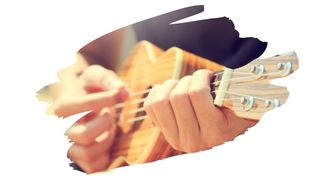It’s little secret that Koa wood is the number one choice for making ukuleles. But, it’s also no secret that this Hawaiian grown hardwood is fairly pricey to get a hold of.
So, as a result, other more affordable choice lumbers have started to rise in popularity for making ukes.
Take for example, Mahogany. This rich brown hardwood is widely used for making guitars and other acoustic instruments. But, is Mahogany wood also suitable for making quality ukuleles?
Well, in this post, you’ll discover which types of wood are ideal for making ukes. You will also learn what the similarities are between Acacia and the traditional ukulele wood of choice, Koa wood.
And keep reading to find out how Mahogany wood compares as a choice tonewood.

This post may contain affiliate links to products that we receive a commission for (at no additional cost to you). Learn more here.
What Type Of Wood Is Best For A Ukulele?
Ukulele’s have traditionally been made using Koa wood. This hardwood grows abundantly right across Hawaii. And this timber is ideal for giving us those rich midrange tones that have become synonymous with this instrument.
This hardwood is pretty costly though, so alternative ukulele wood options have cropped up in recent years.
For example, other hardwoods such as Rosewood and Maple, are increasingly used to make the sound box. While Mahogany is popularly used for making the sides and bottom of a ukulele.
Related Post: Can You Put Olive Oil On A Solid Wood Ukulele?
Is Acacia Wood Good For Making Ukuleles?
Well, Koa wood and Acacia wood are both from the same tree family.
But, the Acacia tree family is vast. And at last count, there are over 1200 different subspecies of Acacia wood in the world.
The properties of these various different Acacia subspecies can vary quite wildly. Especially in terms of their density (which is key to effecting sound resonance).
However, the particular species traditionally used for making ukuleles is of course the Hawaiian Acacia Koa. Still, other types of more affordable Acacia wood can be substituted for Koa.
What About Mahogany? Is It Good For Ukuleles Too?
Genuine Mahogany wood is a fantastic option for great sounding acoustics.
What’s more, Mahogany is more affordable than Koa, but that doesn’t mean its cheap. Rather, it is durable, easy to work with, and resonates with a subtle midrange tone.
Why Is It Called Genuine Mahogany?
Well, because there’s another type of timber that looks very similar to Mahogany. So much so, that the two often get confused.
Sapele is another type of wood used for making acoustic instruments. It belongs to the same family tree as Mahogany wood. And it resonates with a similar sound to it as well.
But, while Genuine Mahogany is generally sourced from South America, Sapele is grown in and around West Africa. And so Mahogany wood was given the moniker of ‘Genuine’ in front of its name to help differentiate the two in the marketplace.
Still, there is one very obvious difference between Sapele and Genuine Mahogany wood, and it lies in their heft. Sapele is heavier and tougher than Mahogany wood.
Related Post: Is Sapele A Good Wood For A Ukulele?
Is Acacia Pretty Much The Same As Mahogany As Well?
No, not at all. They belong to different tree species, they have different density levels, they look different, they sound different…the list goes on.
For example, Mahogany wood is not as heavy as Acacia Koa wood. The difference isn’t worlds apart, but it is still there.
Also, Mahogany wood has an earthy tone to it when played, perfect for midrange tones. While Koa wood has a comparatively brighter yet dryer sound to it.
But, Aren’t Mahogany Ukuleles Fairly Heavy?
Not really. Once you’ve hollowed out Mahogany, it is fairly lightweight. Even lighter than Koa wood.
Regardless, the weight difference between the two is almost negligible. Especially since your instrument won’t be made from solid Mahogany or solid Koa wood either way.
So, Is Acacia Koa Or Mahogany Better For A Ukulele?
If you’re after a traditionally looking ukulele that’ll play clear crisp tones, then Acacia Koa wins hands down.
But, if you want a more affordable ukulele that can also produce powerful midrange frequencies, then Mahogany is a great choice.
Related Post: What’s The Best Ukulele Conditioning Oil?
To Wrap Up, Here Are The 3 Key Takeaways From This Post…
- 1). Koa wood is a subspecies of Acacia wood.
- 2). Mahogany, (also referred to as Genuine Mahogany), is great for making the sides and bottoms of ukuleles.
- 3). Mahogany is more affordable than Koa wood. However, Koa wood produces clearer crisper tones than Mahogany.
References:
Clowes, Austin, and Emily Kaldjian. “Building a Sustainable Guitar: Koa.“
